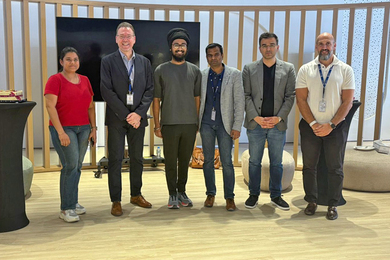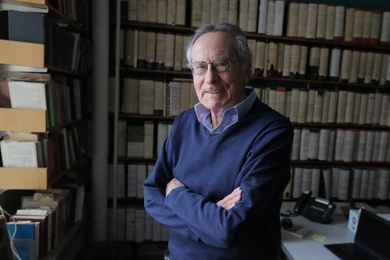During an intense U.S. presidential campaign, millions of people are chatting about the election every day on Twitter. MIT is studying them. More precisely, the Laboratory for Social Machines, part of the MIT Media Lab, has launched a project called the Electome that charts Twitter in unique detail. Now the project has joined forces with the Commission on Presidential Debates — the first debate is tonight — to provide journalists with a “dashboard” summarizing Twitter use during the debates. MIT News talked to three key Electome researchers about their work: Deb Roy, director of the Laboratory for Social Machines and chief media scientist for Twitter; William Powers, long-time journalist, author, and now research scientist for the Electome project; and Russell Stevens, deployment lead for the Electome project. This interview has been edited for length.
Q: What is the Electome and how does it work?
Deb Roy: It begins with taking two data sources: 30 English news sources and the fire hose of tweets from Twitter. We designed machine-learning algorithms that classify both the news stories and the tweets according to a taxonomy of topics on the U.S. election. It’s creating an organized view of how those two streams intersect or diverge, if there are systematic differences of news coverage versus what’s being discussed on Twitter. The overall goal here is to leverage this social signal, which is now of central importance in this election cycle, and systematically understand that signal’s relationship to the news media, and ideally create some sort of feedback loop.
William Powers: The debate commission is trying to solve this same problem. There is this new public sphere with all these voices, and yet it’s very hard to get your arms around it, precisely because there are so many voices. We had a long conversation [with the commission] over the winter and [then] built this dashboard.
Q: In that case, how would you like to have journalists use this tool during the debates?
Russell Stevens: We prefer it to be used as a bit of a step-back machine. We’re working to provide this data in almost real-time, but we’ve thought from the beginning it works better with a little perspective about how the conversation changed because of the debates. We would like journalists to use this to think about what the candidates talked about during the debates and how people in the wilds of Twitter have responded to that in their own conversations — to see how that discussion has changed.
Q: During the campaign as a whole, what are some cases in which the conversation on Twitter has diverged notably from mainstream news media coverage or public perception of the issues?
Roy: During the vice-presidential selection process there was a two-week period [when] a third of all stories across all leading news sources were about [that process]. In the same two-week period, we found about 3 percent of tweets were about the vice-presidential issue. The journalists were literally an order of magnitude more interested than the millions of people on Twitter.
Stevens: Ethics — which is how we [classify topics such as] email and campaign finance — has been covered much more in the media than it’s been talked about [on Twitter]. That is a pretty clear trend from early on. … We [also] found how much the election is not about “the economy, stupid,” in the classic [Bill] Clinton phrase. Issues like national security, foreign policy, immigration, guns, and racial issues are being spoken about [more], relative to economic issues, the budget, taxation, jobs, and even income inequality.
Roy: A search of the term “birther” [shows] a spike [in tweets] when Trump held a press conference [on the subject]. What’s interesting here, from our automatic coding, is that the majority of the spike comes from race-related tweets. It makes it quantifiable what the reaction is. … Although Trump is careful not to talk about President Obama’s birth place in racial terms, the public reaction to his comments on Twitter is overwhelmingly racial.
Q: Are there any other surprises about the election you’ve seen due to the Electome project?
Stevens: There’s a very interesting gender breakdown in terms of who’s been tweeting about the election, and it’s running very strongly male. What would classically be considered social issues within the election … is very strongly dominated by racial issues, immigration, and guns, and the two gender-oriented issues of LGBT issues and abortion rights have indexed very, very low relative to the other issues. It’s interesting, although I think we have to be careful about attributing causality to this.
Powers: I have three surprises. One is the changing nature of influence. If Twitter is some kind of indicator of where influence is going in the digital world, [then] people who are not famous [according to conventional terms] are having influence. Second, as a long-time Washington journalist, the prominence from early 2015 of foreign policy and national security was a surprise to me. Third, it is interesting in the data to see the way events outside the election bubble change what’s happening in the election bubble. We did an analysis of the Orlando massacre, and the election issues that were affected — guns, immigration, LGBT, terrorism — took a big jump [in volume of Twitter discussion]. The membrane between politics and the rest of the world is, in a way, more permeable than we had thought.












